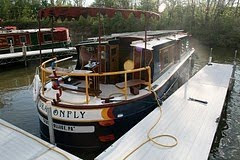SlowBoat will depart
for her cruise west to Buffalo later this week. Meanwhile we continue to catch
you up on her adventures during the July 2019 cruise down Cayuga Lake.
 |
| Fins cutting the water. Cue the "Jaws" theme music . . . |
We didn’t need an alarm clock to wake us during our stay at Treman Marina. We were jolted
out of sleep each morning by the sound of loud thrashing next to the hull.
It sounded like dolphins playing. But the creatures who were breaching and
lobtailing and fin-slapping were actually common carp.
Infesting U.S. Waters for Nearly Two Centuries!
Common carp have been messing up North American ecosystems
much longer than the high-flying Asian carp we encountered on the Illinois
River during our Great Loop Cruise. Those guys were brought to the U.S. in the 1970s to clean up algae in catfish ponds. The U.S.
Commission of Fish deliberately brought common carp to New York State long before that--as early as 1831.
Releasing a prolific, ecosystem-destroying
species into the New World? Those government biologists thought it was a smart move. Settlers had fished
out many native species. Back in Europe, carp farming had
been a common practice for 2,000 years. Why not bring over a tasty fish that’s easy to farm,
and that homesick settlers like to eat?
Oops, mistake.
Fish That Pig Out
 |
| Three-foot-long carp spotted at the dock in Newark, NY. |
 |
| This is a weed harvester. Carp do the same job, only in a messier way. |
Carp can grow to 50 pounds or more (picture a medium -sized dog!) And they can live for 20 years.
Carp aren't solely responsible for native fish declines. During the industrial revolution,
paper mills, power plants, chemical plants and more dumped pollutants into
American rivers.
Native fish died off, but carp were survivors, hard-wired
to tolerate low oxygen levels, warm water, and pollutants.
In one study, biologists exposed carp to 1,600 common pollutants. Only 135 of them were reliable carp killers.
Let’s Go Carpin’
If 19th -century
Americans welcomed carp as a source of food, some folks today find carp to be exciting game fish. Believe it or not, you can fly-fish for carp, just as
you would for trout, and anglers consider them to be exciting and challenging
prey.
It’s also legal to bow-hunt for carp—yup,
shoot into the water with a bow and arrow. As long as you have a fishing license (or a
small game hunting license) and you’re in an area where bow-hunting is legal,
go for it.
Speaking of bow-hunting for carp. During our Great Loop Trip we learned about a brand-new way to bow-hunt for fish. Asian carp can jump six feet straight up
out of the water when startled, so bow-hunters now go after them on the fly—trying
to shoot them in mid-air.
Let’s Go Skarping Now, Everybody's Learning How
Ten years later, I’m pleased to
report the evolution of yet another new carp-related sport: Skarping. Developed
in the every-innovative town of Peoria, Illinois, It’s a combination of skiing
and carping.
Just strap on your water skis or wake board plus a
helmet and some body armor (a trash can works well). Arm yourself with a weapon
(broadsword, boomerang, wolverine claws . . . the choice is yours). Find a
friend who has a fast boat, get up on plane behind it, and as the carp start to
fly, hit them with your weapon.
Check out this video . . .
I hear dunking your catch
through a basketball hoop is optional, but earns points for style.





No comments:
Post a Comment